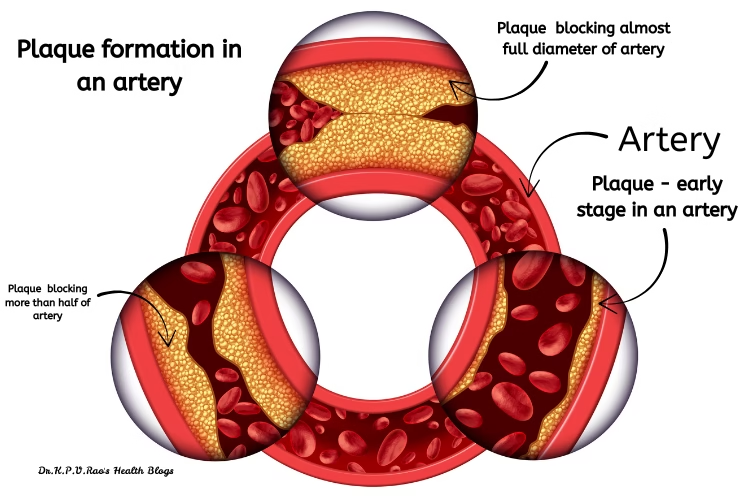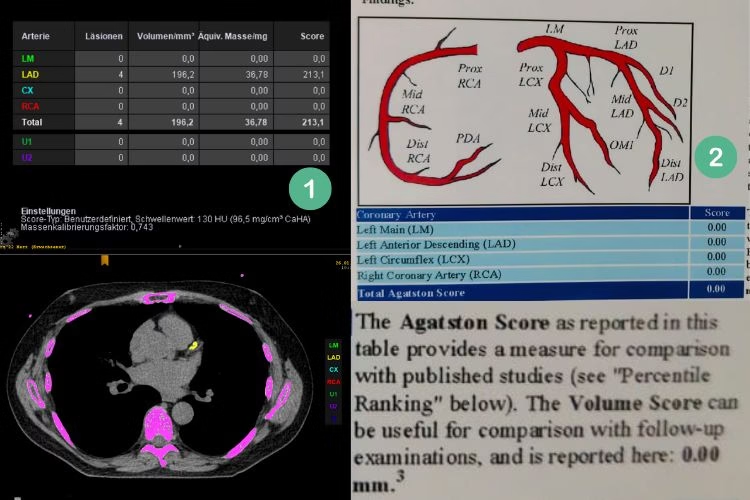After studying about CT angiogram , often known as computed tomography angiography cta, carried out by a process known as CT-angiography, we transfer forward to be taught extra about it, and its makes use of.
On this article we’ll find out how doing a CT-angiography carried out in a suspected case of coronary coronary heart illness may help the affected person to forestall future occasions like coronary heart assault. A multislice ct angiography may help us find out about
So, let’s start by-
Levels in Assessing Plaque Well being within the Coronary heart
To start with, let’s perceive what a plaque means. Plaque is a deposit of ldl cholesterol within the wall of the coronary or coronary heart artery. Additional time, this plaque grows after which blocks the lumen of the artery, thereby chopping off the blood provide to the guts muscle inflicting damage or demise of the muscle in that space.
The image under exhibits how a small plaque initially progresses to dam an artery totally:

The analysis of plaque well being throughout the coronary arteries is essential for understanding cardiovascular dangers and guiding therapy methods.
This evaluation is usually performed by a number of distinct levels, beginning with the classification of plaques, which might differ in morphology and composition.
Classification of plaques in CT-Angiography of Coronary heart
The 2 major kinds of plaques recognized in CT-angiography of the guts are steady (calcified) and unstable (non-calcified or combined).
As soon as the plaque is classed, the following stage entails visualization strategies employed by CT-angiography. Superior imaging permits for detailed evaluation of plaque traits, reminiscent of thickness, density, and the presence of a lipid pool. These particulars are important as a result of they supply insights into the steadiness of the plaque, informing scientific selections concerning the necessity for intervention or nearer monitoring. Excessive-resolution CT scans can reveal delicate adjustments in plaque construction, highlighting areas that will warrant additional investigation or therapeutic intervention.
Plaque Calcium Rating Measurements utilizing CT-angiography
Furthermore, quantitative measurements such because the Agatston rating can help cardiologists in assessing the general burden of coronary artery illness.
This scoring methodology evaluates calcium ranges inside plaques, providing a dependable estimate of plaque severity and the potential for adversarial occasions. The correlation between plaque well being evaluation through CT-angiography of the guts and affected person prognosis is important because it contributes to danger stratification and individualized therapy planning. Consequently, understanding plaque well being shouldn’t be merely an educational train however carries substantial implications for affected person outcomes and long-term administration of cardiovascular well being.
Significance of Plaque Calcium Rating in Coronary heart Well being
Plaque calcium rating measurements are an necessary development in assessing the cardiovascular well being of sufferers. Derived from CT-angiography of the guts, these measurements make the most of superior imaging strategies to detect and quantify the quantity of calcified plaque throughout the coronary arteries. This data performs a essential function in evaluating an individual’s danger for cardiovascular occasions, reminiscent of coronary heart assaults and strokes, which are sometimes related to atherosclerosis—a situation characterised by the buildup of plaque within the arteries.

2. Picture of CT- angiography of certainly one of my sufferers with Agatston Rating
The scoring system for calcium scoring usually employs the Agatston methodology, which is extensively accepted in scientific follow.
On this methodology, the quantity of calcium current within the coronary arteries is quantified and assigned a rating.
The scoring ranges from zero, which signifies no detectable calcium and a low danger of coronary heart illness, to increased scores that correlate with elevated ranges of calcified plaque and a corresponding rise in cardiac danger. As an example, a rating of 1-10 suggests minimal danger, whereas scores above 400 are related to the next chance of great coronary artery illness.
These calcium scores derived from CT-angiography present useful insights into the general coronary heart well being of sufferers. They may help information therapy selections, permitting healthcare suppliers to develop applicable danger mitigation methods.
Moreover, sufferers with elevated scores could also be suggested to interact in way of life modifications, reminiscent of improved weight loss program and elevated bodily exercise, or could also be candidates for pharmacotherapy to decrease their cardiovascular danger.
Understanding plaque calcium rating measurements, together with different scientific assessments, is important for efficient cardiovascular danger administration.
What are the advantages of CT-Angiogram
CT-angiography of the guts affords a number of benefits over conventional diagnostic strategies reminiscent of invasive coronary angiography and different imaging modalities. One of many major advantages of this non-invasive imaging approach is that it minimizes affected person danger. In contrast to conventional angiography, which requires catheter insertion into the blood vessels, CT-angiography makes use of superior imaging know-how, thereby avoiding issues related to invasive procedures.
One other important benefit of CT-angiography is the velocity at which ends up are obtained. In scientific settings, well timed prognosis is essential, particularly for circumstances associated to coronary artery illness. A CT-angiogram can typically be carried out inside a matter of minutes, and the imaging outcomes can be found promptly, permitting physicians to make fast and knowledgeable selections a few affected person’s care. This expedited course of is useful for each healthcare suppliers and sufferers, because it helps within the well timed administration of potential coronary heart points.
Furthermore, CT-angiography of the guts offers an in depth, three-dimensional view of the coronary arteries. This stage of element is invaluable for assessing the presence and extent of coronary artery illness, because it permits for an correct analysis of blood stream and any blockages that will exist throughout the arteries. The high-resolution photographs obtained can reveal not solely the anatomy of the arteries but in addition the diploma of stenosis, thus serving to in tailoring applicable therapy plans. As well as, CT-angiography might be significantly helpful in sufferers the place conventional strategies could be much less efficient or the place integrating outcomes may improve diagnostic accuracy.
General, the non-invasive nature, speedy consequence turnover, and detailed evaluation offered by CT-angiography of the guts make it a most popular alternative for a lot of clinicians within the analysis of cardiac circumstances and affected person administration.
Potential Dangers and Concerns
Whereas CT-angiography of the guts is extensively thought to be a useful diagnostic device, it is important to think about potential dangers and necessary elements related to the process.
One major concern is radiation publicity. CT scans make the most of ionizing radiation, which might contribute to an elevated danger of most cancers over a lifetime, significantly in sufferers who bear a number of scans.
Regardless of this danger, the advantages of acquiring correct diagnostic data typically outweigh the potential hurt, significantly when performed judiciously and in accordance with present scientific pointers.
One other important consideration entails using distinction brokers throughout a CT-angiogram of the guts. Most procedures make use of iodinated distinction supplies, which assist improve the visibility of blood vessels.
Nevertheless, these brokers can provoke allergic reactions in some sufferers. Reactions might vary from delicate signs, reminiscent of hives or itching, to extra extreme responses, together with anaphylaxis. Sufferers with recognized allergy symptoms to iodine or shellfish ought to inform their healthcare supplier, who might take extra precautions or take into account different imaging strategies if deemed needed.
Moreover, sure affected person populations might face extra challenges when contemplating a CT-angiogram. People with compromised renal operate are at heightened danger of contrast-induced nephropathy, a situation that may result in acute kidney damage.
Sufferers with diabetes or these taking drugs that have an effect on kidney operate needs to be intently monitored. Moreover, pregnant ladies are typically suggested to keep away from pointless radiation publicity until completely required for maternal or fetal well being, necessitating an intensive dialogue of dangers versus advantages with a healthcare skilled.
In gentle of those issues, it’s essential for sufferers to interact in an open dialogue with their medical suppliers, making certain that every one potential dangers related to CT-angiography of the guts are totally understood and managed appropriately.
Future Traits in CT-Angiography
The sphere of CT-angiography of the guts is repeatedly evolving with developments in know-how, which promise important enhancements in each diagnostic accuracy and affected person outcomes.
One of the vital noteworthy tendencies is the mixing of synthetic intelligence (AI) in picture evaluation. AI algorithms have demonstrated a outstanding capacity to reinforce picture high quality and help radiologists in deciphering advanced datasets.
By automating sure facets of picture evaluation, these applied sciences can scale back human error, streamline workflows, and speed up the identification of essential cardiovascular circumstances.
Moreover, developments in imaging strategies are pushing the boundaries of what CT-angiography can obtain. For instance, the event of dual-energy CT imaging permits for the differentiation of varied tissue varieties, which might be significantly helpful when evaluating coronary artery ailments.
This know-how not solely enhances the distinction decision but in addition enhances the power to detect delicate adjustments in plaques that will in any other case go unnoticed. Such refinements in imaging capabilities allow clinicians to develop extra tailor-made therapy plans for sufferers, in the end enhancing preventive care.
Furthermore, the way forward for CT-angiography might contain the incorporation of purposeful imaging, which assesses the physiological facets of blood stream and cardiac operate concurrently.
Such complete imaging approaches can present a extra holistic view of a affected person’s cardiovascular well being, permitting for a extra correct prognosis. Integrating these developments into normal follow may revolutionize the panorama of cardiac diagnostics.
Conclusion
In conclusion, the long run tendencies in CT-angiography herald thrilling potentialities for the realm of cardiovascular imaging.
The mixture of progressive imaging strategies and AI-driven evaluation holds the potential to considerably enhance diagnostic precision and affected person administration, paving the way in which for enhanced scientific outcomes within the administration of heart-related ailments.
Remaining phrases
When you have discovered this text helpful, please share it on X-
CT Angiography Analysis and far more… Share on X
Do be a part of my electronic mail listing to obtain extra articles like this one in your inbox –
Please allow JavaScript in your browser to submit the shape
You can too share this text through social media apps below-